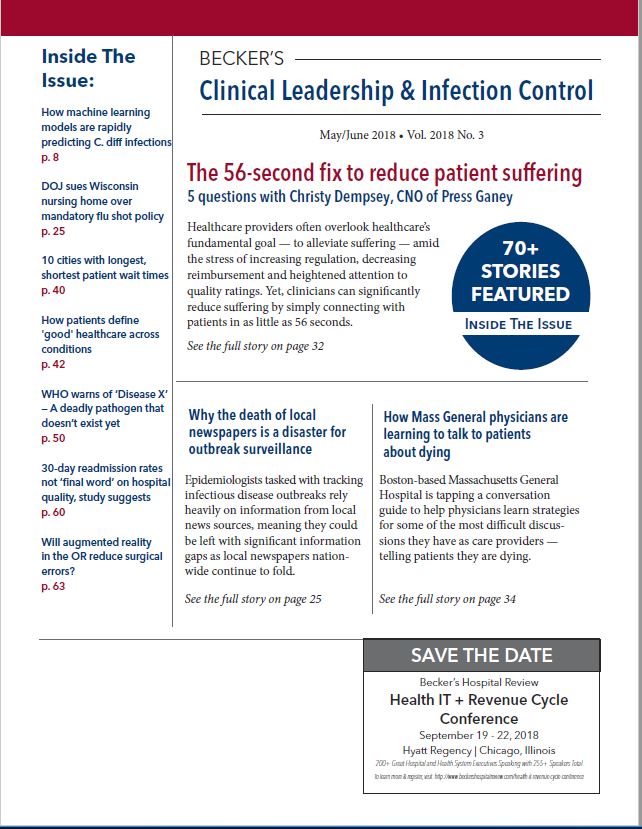ON THE COVER
The 56-second fix to reduce patient suffering 5 questions with Christy Dempsey, CNO of Press Ganey
Healthcare providers often overlook healthcare's fundamental goal — to alleviate suffering — amid the stress of increasing regulation, decreasing reimbursement and heightened attention to quality ratings.CLICK HERE TO CONTINUE
Why the death of local newspapers is a disaster for outbreak surveillance
Epidemiologists tasked with tracking infectious disease outbreaks rely heavily on information from local news sources, meaning they could be left with significant information gaps as local newspapers in large swaths of the U.S. continue to fold, according to a report from STAT. CLICK HERE TO CONTINUE
How Mass General physicians are learning to talk to patients about dying
A conversation guide is helping physicians learn strategies for some of the most difficult discussions they have as care providers — telling patients they are dying. CLICK HERE TO CONTINUE
INFECTION CONTROL & PATIENT SAFETY
OIG: DC VA hospital had 375+ patient safety incidents in 2 years
A recent investigation by the U.S. Office of Inspector General found U.S. Department of Veterans Affairs officials at nearly every level knew of sterilization issues and equipment problems at the Washington DC VA Medical Center, but were either unwilling or unable to fix those issues, putting patients at risk, according to a USA Today report. CLICK HERE TO CONTINUE
Infectious disease deaths drop in US: 5 study findings
Overall, deaths from infectious diseases are declining in the U.S. — but these improvements varied significantly among counties — according to a study published in JAMA. CLICK HERE TO CONTINUE
EXECUTIVE BRIEFING
APPs in leadership roles: Key opportunities and considerations for hospitals
Advanced practice nurses and physician assistants are playing increasingly important roles in patient care and organized leadership, stirring up a new set of challenges and opportunities for hospitals and health systems. CLICK HERE TO CONTINUE
Indigo-Clean: A Revolutionary New Way to Battle HAIs
According to the CDC, on any given day, roughly one out of every 25 patients in U.S. hospitals contracts an infection. The agency estimates approximately one-fourth of patients with HAIs develop the infection during surgery. CLICK HERE TO CONTINUE
The importance of advances in nasal decolonization for current and future infection prevention
Nasal carriage of Staphylococcus aureus has been reported in 30 percent of the population, and methicillin-resistant Staphylococcus aureus in 3 percent to 5 percent of the population. CLICK HERE TO CONTINUE
The power of light: How hospitals can harness UV energy to reduce HAIs
As hospitals and health systems work to reduce healthcare-associated infections, a number of harmful pathogens, such as Clostridium difficile, may evade traditional disinfectants and manual cleaning processes. CLICK HERE TO CONTINUE
How hospital leaders can harness intraoperative technology to fight SSIs in high-risk surgeries
As hospitals and health systems work to prevent surgical site infections — particularly in high risk abdominal surgeries, such as colorectal procedures, where patients face a significantly higher infection risk — surgeons can incorporate emerging medical technology during the intraoperative stage to protect patients against harmful bacteria that enter incisions during surgery. CLICK HERE TO CONTINUE
With hand hygiene compliance, there’s no such thing as ‘good enough’
As healthcare costs continue to pile up and superbugs raise new concerns, hospital leaders should look to button up their organization's approach to a seemingly simple task that continues to be stumbling block for too many hospitals — hand hygiene. CLICK HERE TO CONTINUE
PATIENT EXPERIENCE
97% of patients comfortable with sexual orientation questions, Mayo Clinic study finds
Up to 97 percent of patients are comfortable with questions from their healthcare provider on their sexual orientation and gender identity. CLICK HERE TO CONTINUE
Viewpoint: Failing to tell patients they are inoperable may make them suffer more
Although it is difficult for physicians to tell chronically ill patients that treatment is futile, when physicians fail to tell patients treatment is futile, it may only make them suffer more, argues retired gastroenterologist Samuel Harrington, MD, in The Washington Post. CLICK HERE TO CONTINUE
ANTIBIOTIC RESISTANCE & STEWARDSHIP
Global antibiotic consumption soared 65% in 16 years
Antibiotic use increased 65 percent worldwide from 2000 to 2015, according to a study published in the Proceedings of the National Academy of Sciences. CLICK HERE TO CONTINUE
QUALITY IMPROVEMENT & MEASUREMENT
Increased hospital payments linked to better heart attack outcomes: 4 things to know
Higher 30-day spending to care for Medicare beneficiaries who recently experienced a heart attack is linked to a slight reduction in patient mortality, according to a study and published in Circulation: Cardiovascular Quality and Outcomes. CLICK HERE TO CONTINUE
Press Ganey: Safety, quality, experience and engagement are all interconnected — So why are improvement efforts siloed?
Healthcare organizations must take an integrated approach to improving safety, quality, experience and engagement, as these attributes function interdependently to influence performance, according to Press Ganey's 2018 Strategic Insights report, titled "A Strategic Blueprint for Transformational Change." CLICK HERE TO CONTINUE



